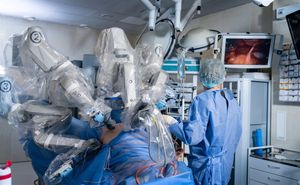Mid-term results for Catalyst CSR™ shoulder system include outcomes for 200+ shoulders and show exceptionally high patient satisfaction scores in a wide age range of patients
Catalyst OrthoScience Inc. (“Catalyst”), a private medical technology leader focused on shoulder arthroplasty, the fastest growing segment in the orthopedics market, today announced positive, mid-term data reporting on patients treated with its Catalyst CSR™ shoulder system was published in the Journal of Shoulder and Elbow Surgery. This is the ninth peer-reviewed publication for the Catalyst CSR system, which has previously shown to more accurately restore the proximal humerus anatomy1,2,3 with earlier improvements in motion than traditional stemmed and stemless shoulder arthroplasty systems.1 The data from this study introduces a new industry benchmark, showing that patients who underwent anatomic total shoulder arthroplasty (aTSA) with the Catalyst CSR system experienced high patient satisfaction, little to no pain, significant functional improvements, and very low revision rates that exceed the average data published for similar aTSA implants.
“At five to eight years, we continue to see Catalyst CSR deliver consistent results with clinically significant improvements for patient outcomes,” said lead author Steven Goldberg, MD, orthopedic surgeon at Physicians Regional Healthcare System in Naples, Florida.
“This real-world data further informs the orthopedic community of the effectiveness of a stemless, ellipsoid shaped humeral implant with a multiplanar osteotomy for aTSA,” said Miguel Ramirez, MD, chief medical officer of Catalyst. “It also underscores our focus on delivering a portfolio of clinically proven solutions that challenge the status quo to help improve the quality of life for the many people receiving a shoulder replacement today.”
This retrospective study of prospectively collected data with 5-8 year completed follow up in 206 shoulders in 179 patients with the Catalyst CSR, suggests that a bone sparing approach coupled with a more accurate reconstruction of the proximal humerus can lead to more normal shoulder functionality following shoulder replacement surgery.
Study highlights include:
- Patient reported outcomes and functionality demonstrated clinically meaningful improvements at just 6 weeks post operatively and all subsequent timepoints.
- 77% of patients reported a Single Assessment Numeric Evaluation (SANE) score ≥ 95 at final follow-up (P < .001), indicating that an exceptionally large percentage of patients perceive their shoulder to be functioning normally.
- Pain medicine requirements were less than traditional TSA, and patients on average voluntarily stopped taking prescription pain medication at 3.4 days postoperatively.
- The bone sparing humeral component was successfully implanted in patients of varying age and bone quality with no humeral loosening, and only 1% with low grade medial calcar stress shielding.
- Only one implant related revision at 5+ years, indicates excellent implant survivorship at nearly 6 years average follow-up.
About the Catalyst CSR Shoulder System
The Catalyst CSR shoulder system, cleared by the U.S. Food and Drug Administration (FDA) in 2016, features a stemless ellipsoid shaped humeral head and multiplanar osteotomy surgical technique. The implant design better replicates the natural shape of the humeral head, while the unique surgical technique minimizes bone removal and preserves the strongest, densest bone for humeral head fixation. The Catalyst CSR system is consistently shown to more accurately restore the proximal humerus anatomy,1,2,3 while sparing up to 72% more bone than traditional stemmed and stemless shoulder arthroplasty systems.4 The less invasive approach, refined surgical technique, and overall efficiency of the Catalyst CSR system, align with the goals of hospitals and ambulatory surgery centers (ASC) to improve access and outcomes.
About Catalyst OrthoScience Inc.
Catalyst OrthoScience, based in Naples, Florida, is redefining shoulder replacement surgery. With a focus on less invasive techniques, fewer complications, and a more natural-feeling shoulder, Catalyst is breaking away from traditional approaches. Our total shoulder systems are engineered for precision and efficiency—preserving bone and soft tissue while enabling delivery of consistent, reproducible results. With a growing portfolio of issued and pending patents, Catalyst technology is available across the U.S. Learn more at www.catalystortho.com and connect with us on LinkedIn.
References
- Budge MD, Orvets N. Stemless Total Shoulder Arthroplasty Using a Novel Multiplanar Osteotomy and Elliptical Humeral Head Results in Both Improved Early Range of Motion and Radiographic Center of Rotation Compared to Standard Total Shoulder Arthroplasty. J Shoulder Elbow Surg 2023, 32: 318-25.
- Baranek ES, Trofa DP, Levine WN, Goldberg SS. Accuracy of Humeral Implant Positioning Using a Canal-Sparing Total Shoulder Arthroplasty System. Journal of Shoulder and Elbow Arthroplasty. 2019; 3: 1–8.
- Cavinatto L, Khatib O, Martusiewicz A, Koueiter DM, Wiater BP, Wiater JM. Radiographic evaluation of humeral head reconstruction with stemmed and stemless spherical implants compared with stemless elliptical head implants. J Shoulder Elbow Surg Int. 2021; 5: 889-893.
- Catalyst OrthoScience. Humeral Implant Volume Comparison. Feb 8, 2018. 12269250-01.
View source version on businesswire.com: https://www.businesswire.com/news/home/20250604865987/en/
“This real-world data further informs the orthopedic community of the effectiveness of a stemless, ellipsoid shaped humeral implant with a multiplanar osteotomy for aTSA.” - Miguel Ramirez, MD, chief medical officer of Catalyst OrthoScience
Contacts
Nicole Nelson
Media Relations
(239) 325-9976





